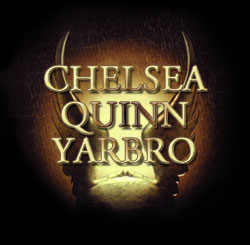
FROM DRACULA TO SAINT-GERMAIN
by Chesea Quinn Yarbro
Unlike traditional literary vampires such as Bram Stoker's Dracula, Chelsea Quinn Yarbro's Count Saint-Germain is known for his heroism rather than his blood lust. In this fascinating essay, based on a talk she gave in 1997 at Boston College, Quinn Yarbro explains why her vampire "treasures the brevity of human life rather than holding it in contempt."In college I took a class in folklore and myth, and found myself renewing my interest in the vampire archetype, first encountered when I read Dracula at age 14. I did a paper on the commonalities and differences in vampire myths worldwide. All vampires take life from their victims, blood being the most common means of accomplishing this, although one Chinese vampire goes in for spinal fluid and Finnic and Eskimo vampires leech body heat. A decade later, I went back to vampire myths and began to make notes on how far from the Dracular model I could go and still have a recognizable vampire. Anything that more than 80 percent of the cultures believed, I took as being true of vampires. Native earth ties, nocturnal activities, lacking a reflection, dying and not staying dead, preying on the living to survive, aversion to sunlight, and discomfort crossing running or tidal water--all were part of the mix. The heavy-handed propaganda of the Christian faith was set aside as grandstanding, as were all other religious spins attached to the myths, since, given the very ancient beginnings of vampires, formal religions were johnnies-come-lately in any case.
The second level of questions arose from the relationship of vampires to humans -- must the relationship be exploitative? And must humans abhor vampires? The more I thought about it, the more I thought it was worth trying to use a vampire as a metaphor for humanism: a person living an unnaturally long life might become alienated from humanity, as a means of avoiding the pain of spending most of your time saying permanent good-byes. Or it was just possible the vampire would, through his very alienation, seek to be part of human experience, which offered a great many more dramatic possibilities.
Related to this realization came my third concern in dealing with the inherent loneliness of semi-immortality and narrowing my previous assessment -- why must the vampire's partners be victims? Wouldn't it be less hazardous if they were cooperative? So victims were out, bringing me to the most basic issue of all: the whole question of the biting and blood. For me, the most conspicuous thing about the blood is its importance to the living partner as well as to the undead vampire. There is a magical power to blood that is as old as human consciousness. Most obviously it is essential to human life, the one thing vampires conspicuously lack. Jungian theory seemed more applicable than other psychoanalytical approaches, and so I used it as a kind of multicultural filter to work out this knottiest core of the mythic vampire figure. Given the sexual wallop vampires pack, the vampiric experience, no matter how it comes about, is loaded with erotic implications. A bite counts as penetration, doesn't it, even though it may be a bit kinky? Suppose the orgasm is part of the payoff for the vampire as well as the vampire's partner? In its most positive form, sexual intimacy is a mutual comprehension that enhances the lives of the participants, revealing and accepting in its nature, getting to the unique individuality of the persons involved. And what is more uniquely personal than blood?
Now that I had hit upon a more positive approach to vampirism and a way of presenting it that was, I hoped, new enough to be interesting but still recognizable as to type, I had to come up with the character, the setting, and the story. Louis XV's Paris, the setting of the first Saint-Germain novel, Hotel Transylvania, was attractive: it was a period I knew something about already; it was visually lavish; there was a great deal of interest in occultism at that time; the society was highly mannered; there was a tolerance of foreigners that made it possible to let this vampire move about in society; women were an active and visible part of society, with a relative amount of autonomy; and it was a society trembling--all unaware--on the brink of collapse. Wonderful stuff for novels.
I also looked about for historical people to lend more authenticity to the story. The more research I did, the more obvious it became to me that the real le Comte de Saint-Germain was the very hero I was looking for. He dressed in black and white (I added the ruby stickpin); he never ate or drank in public; he was a known occultist and alchemist; he claimed to be 4,000 years old and to drink the Elixir of Life; he had more than a dozen identified aliases. He was cultured, talented, intelligent, multilingual, elegant, and humanistic. He was a foreigner whose true national origins were never discovered. He was rich. He was also irresistible. So was his manservant, Roger, who claimed to have served Saint-Germain since Vespasian was Caesar. In a very real sense, the literary Saint-Germain possesses all the raw material that Dracula does, but his experience of vampirism is vitally different. Unlike Drac, Saint-Germain does not get off on taunting his hunters. Unlike Drac, Saint-Germain treasures the brevity of human life rather than holding it in contempt. And, unlike Drac, Saint-Germain offers liberation to his partners instead of demanding the capitulation of his prey. Three publishers, nine editors, and approximately two million words later, Saint-Germain has not even begun to exhaust his possibilities for me. The final outcome of the cycle is in the hands of readers and time, two things that vampires regard as allies.
Copyright © 1997 Chelsea Quinn Yarbro.
All Rights reserved.
Copyright © 2017
DarkEcho Design
